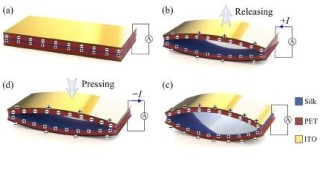Jan 13 2016
Congratulation to Xiaosheng Zhang, who just published his paper on silk TENG in Nano Energy.
 © 2016 EPFL
© 2016 EPFL
In recent years, a new electrification-based mechanism called triboelectric generator (TEG) has been demonstrated as a stable and renewable power source to convert ambient energy into remarkable electrical output. Various TEG configurations have been proposed to enhance the output performance focusing on improvements to its working principle and structural geometry. In order for TEG to make an impact in real life applications, further improvement is needed in particular in the choice of the pair of electrification materials beyond the choice of traditional materials that have been employed in the construction of TEGs. Here, we investigate silk fibroin as a novel material for TEG that occupies a top-tier position in the triboelectric series and possesses the outstanding ability of losing electrons easily. Several technical challenges have been successfully addressed and are shown herein. For instance, an oxygen plasma process is employed to improve the interfacial energy between silk fibroin film and substrate by chemical modification and nanoscale roughness increase, which allows for the reliable switching mechanism needed to generate the electric power. The comprehensive study and the systematical measurement were carried out to study the fabricated TEG, including electrical output test, stability and reliability, humidity effect, and performance comparison with traditional materials. The silk fibroin is proven to be a promising material to construct TEG, and the fabricated TEG exhibits stable high-output performance, with maximum voltage, current, and power density of 268 V, 5.78 μA, and 193.6 μW/cm2, respectively, to a load of 40 MΩ. Furthermore, this silk fibroin film has two advantageous potentials for the development of TEGs: higher than 90% transmittance in the visible spectrum region and controllable solubility in aqueous solutions. The former property preserves the intrinsic optical property of TEG and enables the realisation of an ultra-transparent device, while the latter moves us closer to the attractive future vision of realising TEG systems that biodegradable for environmental sensing or implantable for biomedical applications. Additionally, we demonstrate that this silk-fibroin-based TEG can directly produce energy to power two 4-bit liquid crystal displays (LCDs) and to actuate a microscale cantilever. As the first demonstration of TEG applied to power a mechanical micro-device, this TEG-micro-cantilever microsystem shows an attractive potential to realise fully integrated smart transducers that are needed for autonomous sensor networks.